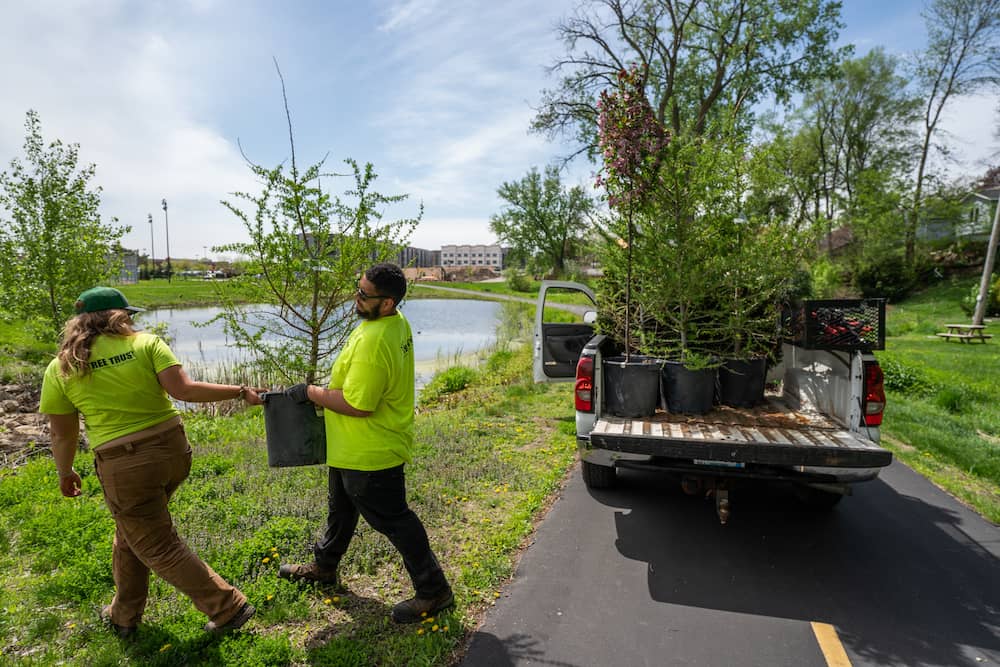One year ago, American Forests launched a tool that would transform the field of urban forestry and its role in addressing systemic social inequities. National and local media outlets, practitioners and frontline organizations alike embraced Tree Equity Score, a tool that synthesizes a large body of data into stories for over 4,000 municipalities and 150,000 neighborhoods across the country.
A neighborhood’s unique number can reveal a multigenerational legacy of disinvestment leading to life-or-death public health impacts today. A future of ever more extreme heat means Boston summers will feel like south Florida, Chicago like central Texas and Phoenix like Kuwait City at 114 degrees. Such temperatures could increase heat-related deaths from 12,000 to 100,000 every year. These casualties will fall overwhelmingly on communities of color, which we found average 48% less tree canopy, and communities of high poverty, which have 33% less cooling tree canopy.

Photo Credit: Michael Jennings / American Forests
With this powerful tool, communities of all sizes have begun telling their unique data-driven story to lawmakers, funders and neighbors while setting goals to take this challenge head-on. Tucson’s Mayor Regina Romero has set a Tree Equity goal to plant 1 million trees. Phoenix’s Mayor Kate Gallego announced a Tree Equity campaign beginning with 100 cool corridors to promote outdoor activity. With an initial budgetary expansion of $1.6 million and support from American Forests’ partners like Salesforce and Bank of America, the Phoenix City Council just approved another $6 million. Las Vegas is likewise a desert city committed to planting 60,000 trees, adding to their 117,000 on public property, while Baltimore County’s Operation ReTree expands trees in high density, lower income areas lacking canopy.
By democratizing this public health, surface temperature, socioeconomic and tree canopy data from EarthDefine into a clean user experience, even smaller communities that couldn’t afford the expense of an urban tree canopy analysis are able to tell their own data-driven story to decision-makers. Central Falls and Pawtucket, R.I., for example, used Tree Equity Score to attract public and private investment to plant on residential properties, which are notoriously difficult to reach yet hold the most potential to expand tree canopy.
As for what comes next, with support from Weyerhaeuser, we are expanding Tree Equity Score to the specific needs of urban clusters of 2,500 to 50,000 residents in rural areas. American Express and Salesforce are helping us include Puerto Rico, Hawai’i, Alaska and our first international pilot.

Photo Credit: Evan Frost / American Forests
From scores to action
The momentum is inspiring, but a number is just a starting point. American Forests has been working with Rhode Island and cities nationwide to develop the most comprehensive change model in urban forestry to help build long-term local capacity.
We have found three hurdles and opportunities emerge again and again to overcome entrenched tree inequity:
- Community Engagement
Showing up out of nowhere with new trees only exacerbates decades of distrust and concern while dramatically lowering the likelihood that those trees will be embraced and nurtured. Residents and frontline organizations have heritage narratives of their community, a vision for its future and pragmatic knowledge that should be compensated. For example, a field that looks perfect for trees from a satellite might be an important gathering place for weekend pick-up soccer games.
With support from Doris Duke Charitable Foundation and Seed Fund, American Forests is refining a community engagement process, learning from the leading-edge of environmental justice best practices.
- Funding
Surprising no one, the biggest hurdle to achieve Tree Equity is funding a chronically underfunded field. Tree Equity Score has proven to be a powerful fundraising tool, but American Forests is working to infuse those efforts with significant financial and technical support from federal legislation and diverse federal agencies, like Housing and Urban Development or Department of Energy.
On the private sector side, we’ve helped develop City Forest Credits, the first-ever urban carbon market. Their first national sale was recently finalized for $1.1 million at a very strong $36 per ton. Future sales are expected to be higher, providing critical maintenance funding over decades. In Detroit, we are also working with Quantified Ventures to conduct our first impact investing analysis of every feasible way the urban forest could be monetized, from fewer hospitalizations to less stormwater and urban wood markets.
- Career Pathways
Perhaps the best way to maximize the economic benefits of a community’s urban forest is to help those who live in it establish careers managing it. This includes overcoming one of our greatest hurdles — awareness our field even exists — with youth career exploration opportunities, pre-employment training and wraparound support to help people get established.
In coming months, voices from our team will dive into these and other aspects of what it really takes to overcome entrenched obstacles and achieve Tree Equity with every community.